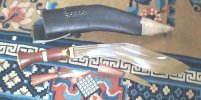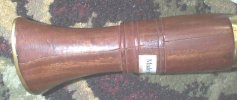- Joined
- Mar 5, 1999
- Messages
- 34,096
Here's an 18 inch 22 ounce fairly light and quick AK by Murali. He's got the blade right up around 60 Rc and it'll take a hair or two off the arm. It's a 10/10 effort with a cracked handle. Good karda and chakma. Same old village sarki scabbard and frog in new leather.
Good to see Murali back at work.
I'll try to get a pix of the handle so you'll see what you are up against.
The handle saves you $50. Take it home for $95.
Call or email.
Good to see Murali back at work.
I'll try to get a pix of the handle so you'll see what you are up against.
The handle saves you $50. Take it home for $95.
Call or email.


